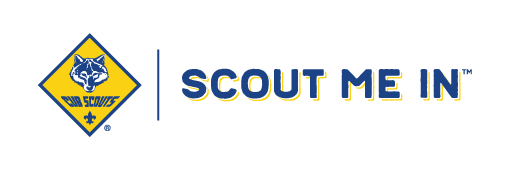Pack Structure and Ranks

A Cub Scout Pack is made up of small dens for Rank which corespondent to each grade level. We do activities as an entire pack but the Den is the heartbeat of the Cubs Scout experience.
Dens

Bobcat – First things first
No matter what age or grade your child joins Cub Scouting, they must earn their Bobcat badge before they can advance in rank. Bobcat requirements include: Learn and say the Cub Scout motto, the Cub Scout promise, and the Law of the Pack and tell what they mean; Show the Cub Scout sign, salute, and handshake and tell what they mean; and Show that you understand and believe that it is important to be honest and trustworthy.

Lion Den
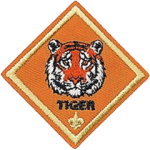
Tiger Den
To begin their path to the Tiger rank, the Tiger (age 7 or first-grade) must learn the Cub Scout promise, the Cub Scout sign, and the Cub Scout salute. When he has learned these, he gets his Tiger emblem, which is a tiger paw with four strings for beads. He wears the emblem on his right pocket.
As a boy finishes each part of the five Tiger achievements, he earns an orange bead (for den activities), a white bead (for family activities), or a black bead (for “Go See Its”). When the boy has earned five beads of each color, he can receive his Tiger badge. The Tiger badge is given to the boy’s adult partner at a pack meeting. Then, during a grand ceremony, the adult gives the badge to the boy.
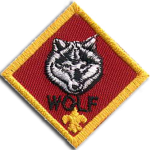
Wolf Den
The Wolf rank is for boys who have finished first grade (or who are 8 years old). To earn the Wolf badge, a boy must pass 12 achievements. His parent or guardian approves each achievement by signing his book. When the boy has met all requirements, the Wolf badge is presented to his parent or guardian at the next pack meeting. During an impressive ceremony, the parent or guardian then presents the badge to the boy.
After he has earned the Wolf badge, a Wolf Cub Scout can work on the 23 Wolf electives until he finishes second grade (or turns 9 years old). He can choose from more than 100 elective projects that may show him new hobbies and teach him skills that will be useful during his Boy Scout years. When he completes 10 elective projects, he earns a Gold Arrow Point to wear under the Wolf badge. For each 10 elective projects after that, he earns a Silver Arrow Point.
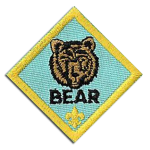
Bear Den
The Bear rank is for boys who have finished second grade (or are 9 years old). There are 24 Bear achievements in four groups. A boy must complete 12 of the achievements to be a Bear Cub Scout. These requirements are harder and more challenging than those for the Wolf badge. When a boy has earned his Bear badge, he may work on electives to earn Arrow Points to wear under his Bear badge.
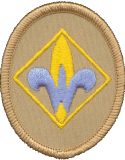
Webelos Den
Webelos dens are for boys who have completed third grade (or reached age 10). The Webelos den program is different from the Cub Scout den program. Everything in the Webelos Scout program is more challenging than what younger boys in the pack do. Webelos Scouts get to work on the 20 Webelos activity badges.

Arrow of Light Den
The highest rank in Cub Scouting is the Arrow of Light Award. Earning this rank prepares a Webelos Scout to become a Boy Scout. Webelos Scouts who have earned the Arrow of Light Award have also completed all
The Beginning of Cub Scouting
Back in England, younger boys were eager to become Boy Scouts. In 1914, Baden-Powell began implementing a program for younger boys that was based on Rudyard Kipling’s Jungle Book. The Wolf Cub program began in 1916, and since that time, Wolf Cubbing has spread to other European countries with very little change.
In America, hundreds of Cub Scout-age boys and their families were clamoring for a program of their own. As early as 1920, Scout executives at the first national training conference discussed the needs of younger boys. The BSA, however, felt it wise to postpone any action until there was more objective evidence.
In 1925, Dr. Huber W. Hurt, a research psychologist and veteran Scouter, was authorized to study existing organizations for younger boys, such as Boy Rangers, Boy Pioneers, American Eagles, and Boys’ Clubs. He found that only one boy in 50 participated regularly in any type of organized leisure-time program. He also found that younger boys responded better to leadership and program efforts than older boys. He worked closely with Ernest Thompson Seton. Both men recommended that the BSA adopt a program for younger boys, with older Boy Scouts as leaders, to tie into home, church, school, and Boy Scouting.
The National Executive Board authorized the Chief Scout Executive to thoroughly investigate the matter. An advisory committee worked with the BSA to develop a plan and produce the necessary literature. Advice was obtained from leading psychologists, sociologists, teachers, school superintendents, professors of education, college executives, and recreation and welfare directors.


By 1929, the new Cubbing program (it wasn’t called “Cub Scouting” until several years later) was taking shape and was introduced as a demonstration project in a limited number of communities. Its structure was similar to today’s Cub Scouting, except that dens were led by Boy Scout den chiefs. The plan included a neighborhood mothers’ committee to encourage Cubs and den chiefs.
In 1930, Cub Scouting was formally launched, with 5,102 boys registered at the end of that first year. By 1933 the time had come to promote Cub Scouting throughout the country as a part of Scouting. All experimental restrictions were removed, and the first national director of Cub Scouting was appointed.
Den mother registration was optional for the first few years. By June 1938, 1,100 den mothers had registered and soon became an important part of Cub Scouting.
The first dens met weekly at a member’s home, where boys played games and enjoyed crafts and ceremonies. The pack met weekly or semimonthly for games, den competitions, awards, stunts, and other activities. Cubs advanced from Bobcat (for all new members) to Wolf (age 9), Bear (age 10), and Lion (age 11) and joined a Boy Scout troop at age 12.
In 1949, the age requirement was lowered to between 8 and 10 for Cub Scouts. In 1982, Tiger Cubs was started based on shared leadership of boy-adult partner teams and the school year calendar. In 1986, Cub Scouts could register as second-grade boys.
Cub Scouting in America is different from the younger-boy programs of other countries because it is centered in the home and neighborhood. With the encouragement of family and leaders, boys enjoy a program that covers a wide variety of interesting things. It suggests activities that boys enjoy doing on their own when adults are not supervising them. These activities are particularly suited to boys of Cub Scout age and are different from those they will encounter in Boy Scouting.
A strong influence from Kipling’s Jungle Book remains today. The terms “Law of the Pack,” “Akela,” “Wolf Cub,” “grand howl,” “den,” and “pack” all come from the Jungle Book. At the same time, the Gold and Silver Arrow Points, Webelos emblem, and Arrow of Light emblem are taken from our American Indian heritage.
